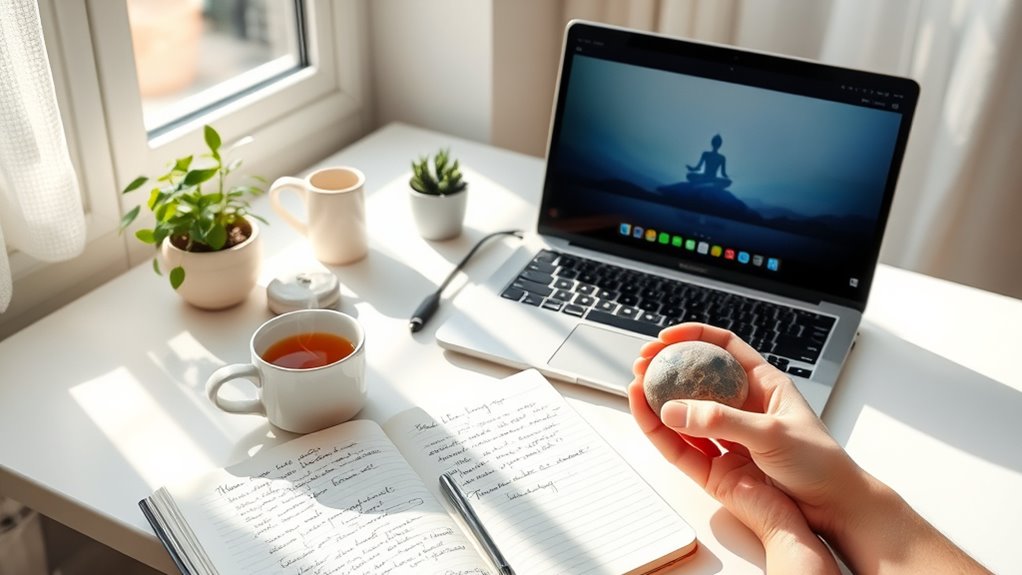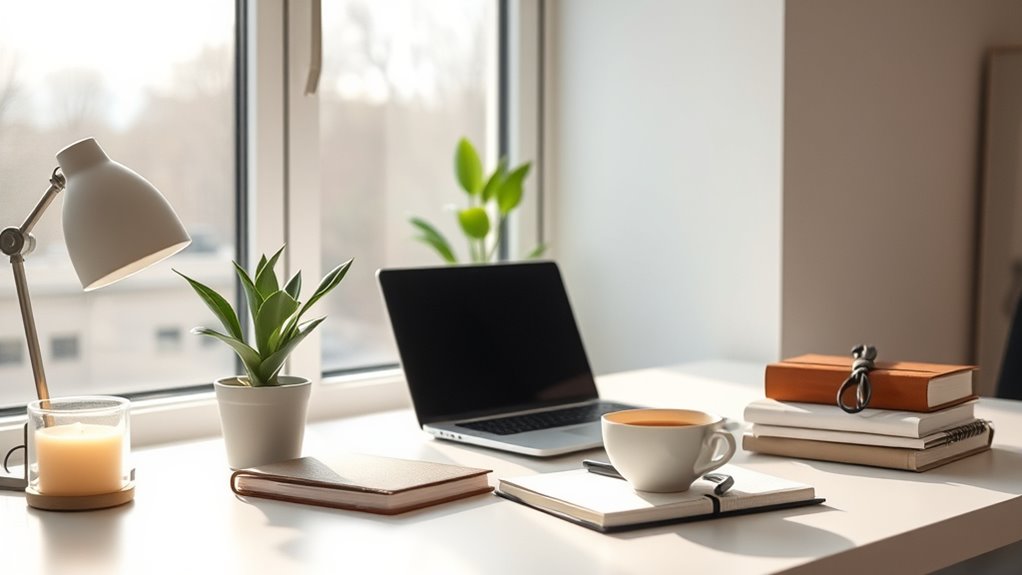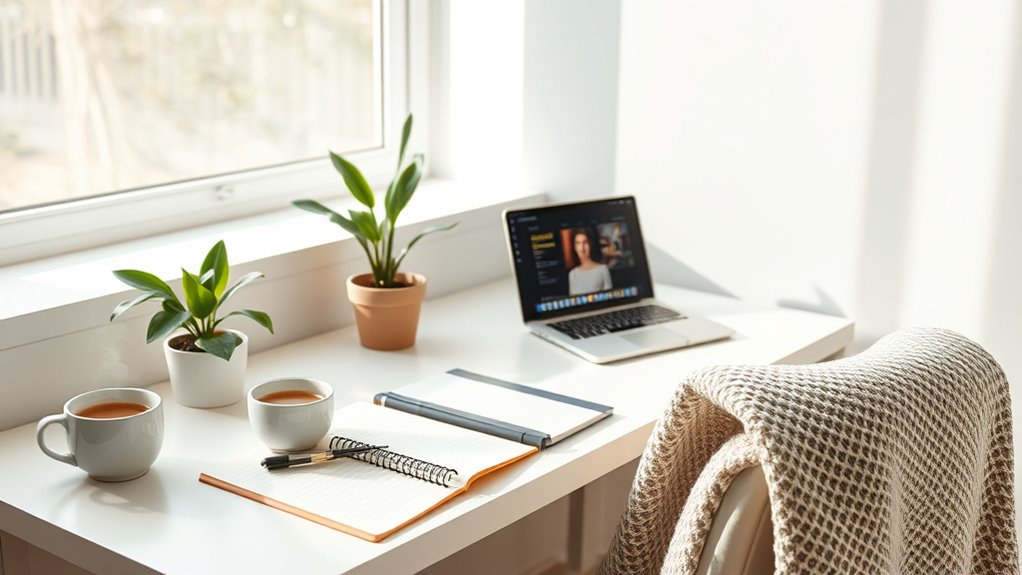To trigger flow state on Monday, start by incorporating mindful breathing into your routine—use deep breaths to center your focus and clear mental clutter. Set clear intentions before each task, defining specific goals to give your work purpose. Adjust your environment with cues like lighting or ambient music to signal your focus zone. These simple steps can help you enter deep work more effortlessly; keep exploring to discover even more effective focus methods.
Key Takeaways
- Incorporate mindful breathing exercises to enhance focus and mental clarity during tasks.
- Set clear intentions before starting to define goals and prioritize focus.
- Use environmental cues like lighting and music to signal transition into deep work states.
- Establish consistent routines and methodologies to build reliable mental triggers for focus.
- Leverage external resources such as industry trends and mindfulness techniques to support concentration.
Incorporating Mindful Breathing to Center Your Focus

Mindful breathing serves as a powerful tool to help you anchor your attention and enter a flow state. When you focus on your breath, you practice mental centering, which clears mental clutter and sharpens your awareness. Begin by taking slow, deep breaths, inhaling through your nose and exhaling gently through your mouth. As you breathe, pay close attention to the sensation of air filling your lungs and leaving your body. This simple act redirects your focus away from distractions and anchors you in the present moment. Regularly incorporating mindful breathing into your routine can help you quickly regain concentration when your mind wanders. Understanding industry trends can also inform your approach to maintaining focus during different types of tasks. Over time, this practice becomes a reliable way to facilitate mental clarity, making it easier to find that ideal flow during your tasks.
Setting Clear Intentions Before Starting Tasks

Before diving into your task, take a moment to set a clear intention. This step enhances goal clarity and sharpens your focus. By mentally preparing yourself, you create a purposeful mindset that directs your energy toward what truly matters. Ask yourself what you want to accomplish and why it’s important. This clarity helps filter out distractions and primes your brain for flow. When your intentions are specific, you’re more likely to stay engaged and motivated throughout the task. Setting this mental foundation at the start ensures you approach your work with purpose, increasing the chances of entering a flow state. A brief pause for goal clarity transforms your task into a focused, meaningful activity. Incorporating mindfulness techniques can further enhance your ability to maintain focus and stay present during your work.
Using Environmental Cues to Signal Transition Into Flow

Environmental cues can act as powerful signals that help your brain shift smoothly into a flow state. Adjusting ambient lighting sets the tone for focus—you might dim the lights to create a cozy, distraction-free zone or brighten them to energize your workspace. Background music also signals your brain to move into deep work; choose instrumental tracks or ambient sounds to minimize interruptions. These cues serve as subtle triggers, indicating it’s time to concentrate deeply. Consistently using the same ambient lighting and background music can strengthen their association with focused work. Over time, your brain begins to recognize these environmental signals as cues for entering flow, making it easier to switch into a productive state quickly and seamlessly. Incorporating consistent methodologies like penetration testing can further reinforce mental triggers for focused effort during complex tasks.
Frequently Asked Questions
How Long Does It Typically Take to Achieve a Flow State?
It usually takes a few minutes to achieve a flow state, but it varies depending on your focus and environment. To speed this up, try mindfulness meditation to clear your mind and creative visualization to imagine success. These techniques help you get into the zone faster. With regular practice, you’ll find it becomes easier to enter flow quickly, boosting your productivity and enjoyment in your tasks.
Can Flow States Be Maintained Across Multiple Tasks or Days?
Imagine your focus as a river, flowing steadily through varied terrain. You can sustain this flow across multiple tasks or days by mastering task sequencing and environment optimization. Just like guiding water through channels, you align tasks to build momentum and minimize disruptions. Consistently setting up a conducive environment helps maintain your flow state, making it easier to stay engaged and productive, even as you move between different projects over time.
What Are Common Distractions That Break Flow During Work?
Distractions like constant notifications, noisy environments, and multitasking often break your flow during work. To stay focused, you should minimize interruptions by silencing notifications and setting boundaries. Optimizing your workspace by decluttering and reducing noise also helps. These strategies allow you to maintain concentration, keep your momentum, and enter a flow state more easily. When you control your environment, you’re less likely to be pulled out of your productive rhythm.
How Does Physical Movement Influence Entering Flow?
Think of your mind as a river flowing smoothly—physical movement acts like a gentle paddle, stirring kinetic energy that clears the way for focus. Incorporating movement habits, like stretching or quick walks, boosts your ability to enter flow. When you move intentionally, you create momentum, making it easier to stay absorbed in tasks. Regular movement keeps your energy high and distractions at bay, helping you dive deeper into your work.
Are There Specific Personality Traits That Facilitate Flow Experiences?
Your personality traits can markedly influence flow facilitation. Traits like openness to experience and conscientiousness make it easier to enter flow, as you’re more adaptable and focused. If you’re naturally curious or persistent, you’ll likely find it easier to engage deeply with tasks. Recognizing these traits helps you tailor your environment and tasks to enhance flow, making work more enjoyable and productive.
Conclusion
By integrating mindful breathing, setting clear intentions, and using environmental cues, you can effortlessly slide into flow. These triggers act like your personal switch to focus and productivity. Remember, success is often about playing your cards right, so build these habits into your Monday tasks. The more you practice, the easier it becomes to stay in the zone. Soon enough, you’ll find yourself riding the wave of flow whenever you need it most.









